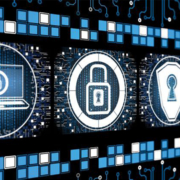Cybersecurity: Why Is it Important?
With cyberattacks on the rise, more organizations are coming to understand why cybersecurity is important to their bottom line. It is essential for businesses of all sizes to use robust cybersecurity best practices to protect their systems, networks, and data. Let’s dive into why cybersecurity is so important for businesses to prioritize.
Cybersecurity: Why Is it Important to Organizations?
| Prevents Financial Losses | Implementing strong cybersecurity practices mitigates financial loss risks. |
| Protects Sensitive Data | Robust cybersecurity safeguards sensitive data from unauthorized access, theft, or misuse. |
| Preserves Reputation, Brand Value, and Customer Trust | Taking robust measures to preserve customer data can enhance a company’s reputation for reliability and trustworthiness. Conversely, the loss of data can have disastrous multi-million dollar consequences, including business devaluation, bad press, and high recovery costs. |
| Complies With Regulations | Prioritizing cybersecurity demonstrates an organization’s commitment to data security and privacy. |
| Safeguards Business Continuity | Investing in cybersecurity protects critical systems and infrastructure, minimizing potential disruptions. |
| Protects Intellectual Property | Robust cybersecurity enables an organization to secure its valuable intellectual property from theft. |
Cybersecurity is crucial to organizations; it is the moat, the heroic knights, and the armor for your castle all rolled into one.
- Financial loss prevention: A successful cyber attack can result in substantial financial losses from theft of funds, disruption of operations, legal liabilities, regulatory fines, customer attrition, brand damage, and costs associated with incident response and recovery. Implementing robust cybersecurity measures mitigates this potential financial harm.
- Sensitive data protection: Organizations handle a vast amount of sensitive and confidential information, including customer data, health information, financial records, intellectual property, and trade secrets. Cybersecurity practices safeguard this information from unauthorized access, theft, or misuse, helping to maintain the trust of customers, partners, and stakeholders.
- Business continuity: Ransomware, distributed denial-of-service, and other types of cyber attacks can disrupt business operations, leading to downtime, productivity loss, and damage to an organization’s reputation. By investing in cybersecurity, businesses can protect their critical systems and infrastructure, minimizing the impact of potential disruptions.
- Compliance with regulations: Many industries have specific regulations and compliance requirements related to data security and privacy. Noncompliance can lead to severe consequences, including legal penalties and reputational damage. By prioritizing cybersecurity, organizations can meet these regulatory obligations and demonstrate their commitment to protecting customer information and maintaining data privacy.
- Preservation of reputation and customer trust: In today’s interconnected world, news of a data breach or security incident can spread rapidly, potentially damaging reputations and eroding customer trust. Investing in cybersecurity demonstrates a commitment to protecting customer data and can enhance a company’s reputation for reliability and trustworthiness. On the other hand, the loss of sensitive information will have costly consequences, including business devaluation, bad press, and high recovery and remediation costs.
- Protection against intellectual property theft: Intellectual property (IP) is a valuable asset for businesses, including patents, trademarks, copyrights, and trade secrets. Cyber attacks can target valuable IP assets, leading to their theft or unauthorized disclosure, which can significantly affect a company’s competitiveness and market position. Robust cybersecurity measures help safeguard against such threats and protect intellectual property.
By investing in cybersecurity, businesses can mitigate risks, enhance resilience, and maintain a solid competitive position in today’s digital landscape.
Cybersecurity Best Practices for Organizations
Implementing strong cybersecurity practices can help protect sensitive data, prevent cyber attacks, and ensure the overall integrity of business operations. Your data is worth protecting, so suit up and grab a sword. Here are some best practices for companies to consider:
- Develop a robust cybersecurity policy: Policy is how we map vulnerabilities, pathways, and roles in the case of enemy infiltration. Create a comprehensive cybersecurity policy that outlines the company’s security objectives, procedures, and guidelines. The policy should address data protection, access controls, incident response, and employee responsibilities.
- Conduct regular employee training: Knights without training are as useful as decorative garden gnomes. Train all employees on security awareness and best practices. Educate them about phishing attacks, social engineering tactics, password hygiene, and keeping software and systems current. Don’t leave your castle in the hands of garden gnomes.
- Use strong passwords and MFA: Empower employees to create strong passwords that are unique and complex with tools like password management software and multi-factor authentication. It is critical that work logins be long, strong, and random (and no, adding “123” or “!” does not, in fact, make it stronger, but nice try!). Implementing multi-factor authentication (MFA) for all relevant systems and applications to add an extra layer of security is one of the most effective steps you can take in case passwords are breached elsewhere. If it seems like overkill, it’s actually just smart.
- Update and patch software regularly: Keep all software, including operating systems, applications, and security solutions, updated with the latest patches and updates. Attackers often exploit vulnerabilities in outdated software. Armor is only effective if you know where the gaps are and how to compensate for the weakened areas.
- Secure network infrastructure: Ensure network devices, such as routers and firewalls, are correctly configured and updated with the latest security patches. Implement network segmentation to isolate sensitive data and limit access to critical systems. These are the moats, mazes, walls, and barbed wire fences around your data.
- Back up data regularly: Every good castle has an escape route. Implement a regular backup strategy to ensure that critical data is securely backed up and can be restored in the event of data loss or a ransomware attack. Test the restoration process periodically to ensure backups are reliable.
- Use data encryption: Implement encryption for sensitive data at rest and in transit. This includes using encryption protocols such as SSL/TLS for website communication and encrypting files and databases that contain sensitive information. And while this may not seem as cool as breaking ancient codes with a cypher, it is just as important.
- Implement strong access controls: Not everyone should be allowed access into the castle. Grant employees access privileges based on the principle of least privilege. Regularly review and revoke access permissions for former employees or those who no longer require access to specific resources. You’d be surprised how easy it is to mistake a trespasser for an ally. Don’t be the one that opens the drawbridge for the enemy.
- Monitor and log all activities: Implement a robust logging and monitoring system to detect and respond to potential security incidents. Technology allows us to have a thousand watchwomen at our fingertips. Monitor network traffic, system logs, and user activities to identify suspicious or unauthorized behavior.
- Develop an incident response plan: When the alarms are sounded that the Keep has been breached, what will you do? Create a well-defined incident response plan that outlines the steps to be taken during a cybersecurity incident. This plan should cover reporting the incident, containing the damage, public relations moves, alerting those affected, investigating the incident, and restoring normal operations.
- Conduct security assessments periodically: Security assessments are the roaming guards on the lookout for abnormalities around the fortress. Perform regular security assessments, such as penetration testing and vulnerability scanning, to identify potential weaknesses in your systems and applications. Address any vulnerabilities discovered promptly.
- Ensure security of third-party vendors: When working with third-party vendors or outsourcing services, ensure they adhere to robust cybersecurity practices. Perform due diligence to assess their security measures and ensure data protection. Be sure you are only letting trusted allies into your kingdom (and remember, trust must be earned).
- Proactively hunt insider threats: One of the most damaging types of breaches happens when data is exfiltrated, damaged, or deleted by an insider you thought you could trust. There are a host of tools to help discourage and detect such malicious behavior.
Cybersecurity is an ongoing effort; the castle will always be desired by outside forces. Regularly review and update your security practices as new threats emerge and technology evolves. It is by setting up multiple lines of defense that we are able to protect what matters most: you and your people, your customers, performance, profits, and reputation.
Employees Are Crucial to Your Cybersecurity Defenses
As the preceding list highlights, employees are a crucial component of your cybersecurity strategy. While technological solutions and protocols are important, human actions and behaviors can significantly impact your overall security posture.
Think of employees as the heroes who keep the castle secure. Employees should be educated about cybersecurity best practices, policies, and procedures in an entertaining way that keeps them engaged. Regular training sessions can help them understand the potential risks, such as phishing, social engineering, and malware, and learn how to identify and respond to such threats appropriately.
To help turn your employees into cybersecurity heroes, award-winning cybersecurity keynote speaker John Sileo uses potent lessons learned from losing his business to cybercrime as well as a humorous live-hacking demonstration to connect with your employees and drive home why cybersecurity is so important.
___________________________
John Sileo is an award-winning cybersecurity keynote speaker who has entertained and informed audiences for two decades. He is proud to have spoken at the Pentagon and Amazon, written four books on cybersecurity, and been inducted into the National Speakers Hall of Fame. He has appeared on 60 Minutes, NBC, ABC, Fox, CNN, Rachael Ray, and Anderson Cooper. John’s work has been quoted and published in The Wall Street Journal, The Washington Post, USA Today, and Kiplinger’s.
Looking for a customized speech to make your next event unforgettable? Call 303.777.3221 or fill out our contact form to connect with Sue, our business manager extraordinaire. She’ll work with you to brainstorm ideas and explore how John can tailor his speech to fit your needs perfectly.






 sileo.com
sileo.com 




